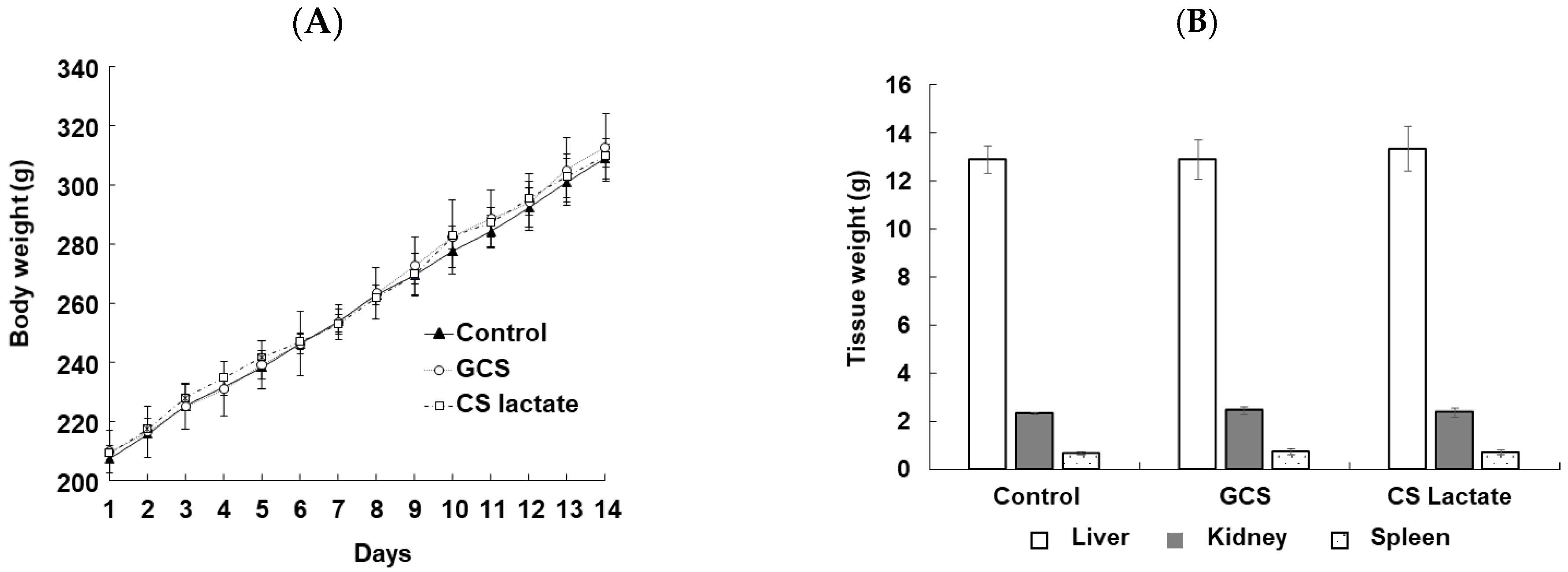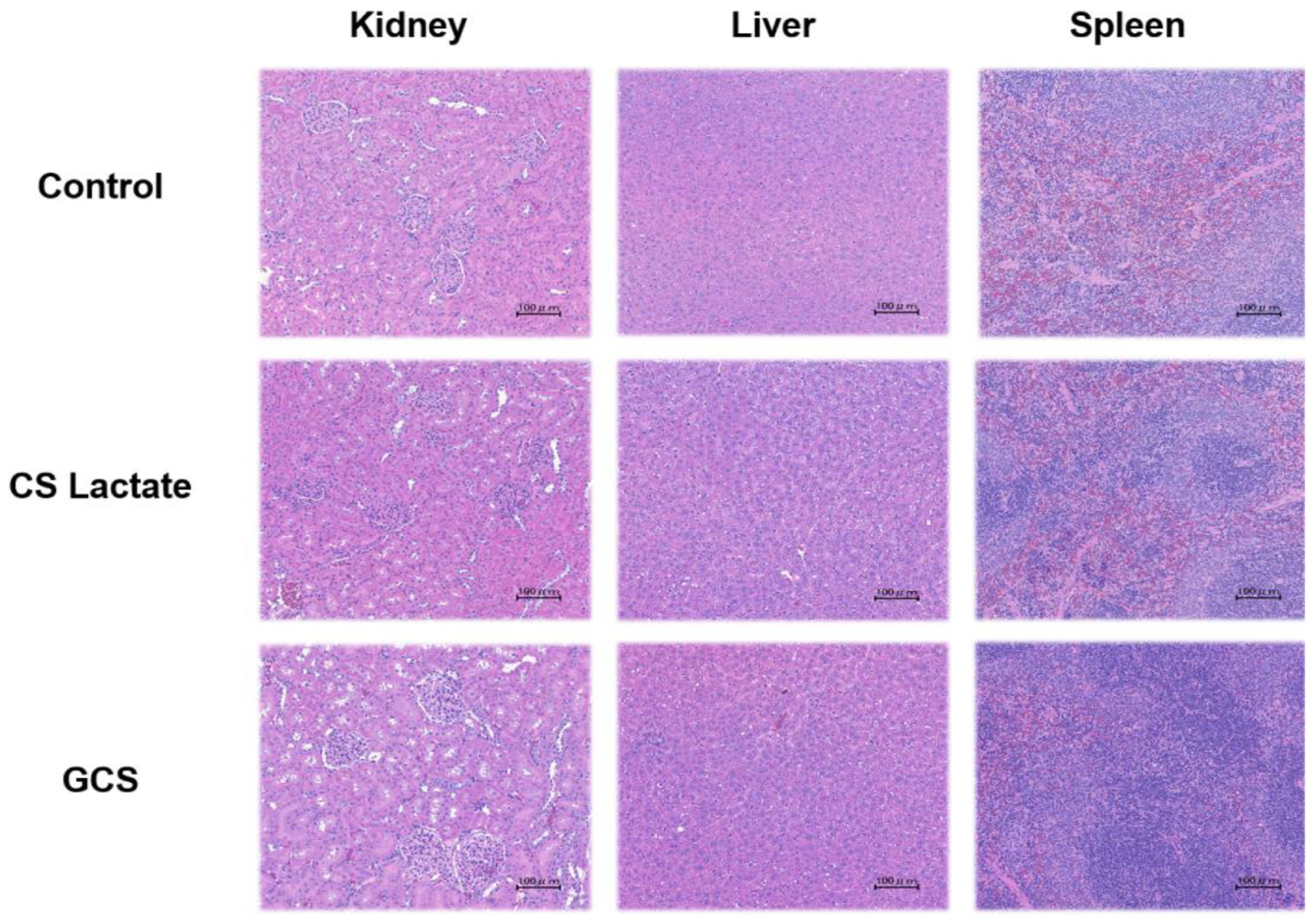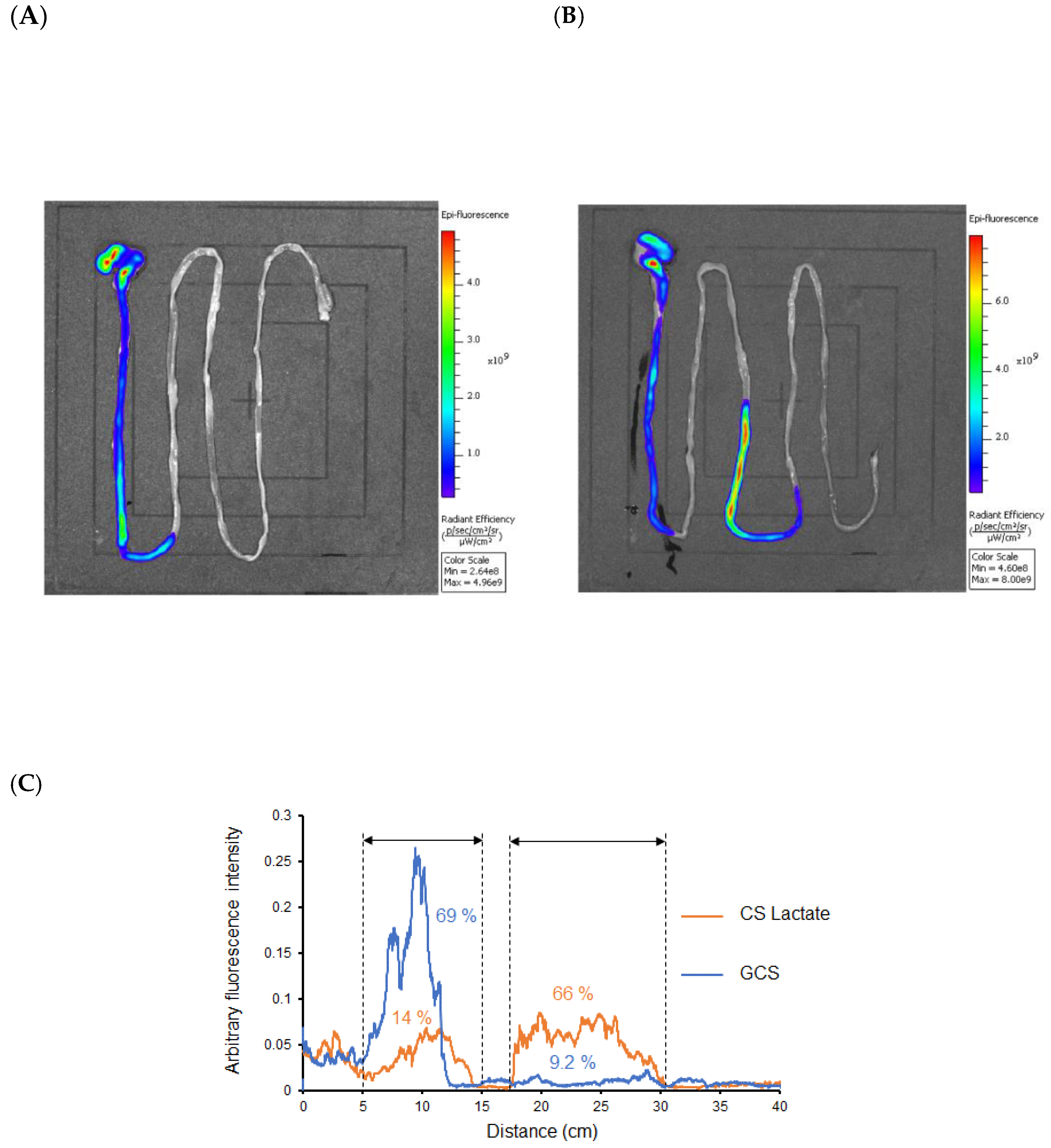Evaluation of the Safety and Gastrointestinal Migration of Guanidinylated Chitosan after Oral Administration to Rats
Abstract
1. Introduction
2. Materials and Methods
2.1. Materials
2.2. Preparation and Characterization of GCS
2.3. Animals
2.4. Safety Studies in Rats
2.5. Evaluation of the Behavior of Rhodamine-Labeled GCS and CS Lactate in the Gastrointestinal Tract in Rats
2.6. Statistical Analysis
3. Results
3.1. Preparation and Characterization of GCS
3.2. Changes in Body Weight, Hematological Parameters, and Major Organs at 2 Weeks after the Administration of GCS and CS Lactate
3.3. Gastrointestinal Retention of Rhodamine-Labeled Chitosan
4. Discussion
5. Conclusions
Author Contributions
Funding
Institutional Review Board Statement
Informed Consent Statement
Data Availability Statement
Acknowledgments
Conflicts of Interest
References
- Illum, L. Chitosan and its use as a pharmaceutical excipient. Pharm. Res. 1998, 15, 1326–1331. [Google Scholar] [CrossRef] [PubMed]
- Anraku, M.; Gebicki, J.M.; Iohara, D.; Tomida, H.; Uekama, K.; Maruyama, T.; Hirayama, F.; Otagiri, M. Antioxidant activities of chitosans and its derivatives in in vitro and in vivo studies. Carbohydr. Polym. 2018, 199, 141–149. [Google Scholar] [CrossRef] [PubMed]
- Ifuku, S.; Saimoto, H.; Azuma, K.; Osaki, T.; Minami, S. Preparation of chitin nanofibers for biomedical application. Chitin Chitosan Deriv. 2014, 10, 169–179. [Google Scholar]
- Jayakumar, R.; Prabaharan, M.; Sudheesh Kumar, P.T.; Nair, S.V.; Tamura, H. Biomaterials based on chitin and chitosan in wound dressing applications. Biotechnol. Adv. 2011, 29, 322–337. [Google Scholar] [CrossRef] [PubMed]
- Kumar, V.; Leekha, A.; Tyagi, A.; Kaul, A.; Mishra, A.K.; Verma, A.K. Preparation and evaluation of biopolymeric nanoparticles as drug delivery system in effective treatment of rheumatoid arthritis. Pharm. Res. 2017, 34, 654–667. [Google Scholar] [CrossRef] [PubMed]
- Oe, T.; Dechojarassri, D.; Kakinoki, S.; Kawasaki, H.; Furuik, e.T.; Tamura, H. Microwave-Assisted Incorporation of AgNP into Chitosan-Alginate Hydrogels for Antimicrobial Applications. J. Funct. Biomater. 2023, 14, 199. [Google Scholar] [CrossRef]
- Maezaki, Y.; Tsuji, K.; Nakagawa, Y.; Kawai, Y.; Akimoto, M.; Tsugita, T.; Takekawa, W.; Terada, A.; Hara, H.; Mitsuoka, T. Hypocholesterolemic effect of chitosan in adult males. Biosci. Biotechnol. Biochem. 1993, 57, 1439–1944. [Google Scholar] [CrossRef]
- Azuma, K.; Nagae, T.; Nagai, T.; Izawa, H.; Morimoto, M.; Murahata, Y.; Osaki, T.; Tsuka, T.; Imagawa, T.; Ito, N.; et al. Effects of Surface-Deacetylated Chitin Nanofibers in an Experimental Model of Hypercholesterolemia. Int. J. Mol. Sci. 2015, 16, 17445–17455. [Google Scholar] [CrossRef]
- Goto, M.; Ifuku, S.; Azuma, K.; Arima, H.; Kaneko, S.; Iohara, D.; Hirayama, F.; Anraku, M. Preparation and evaluation of freeze dried surface-deacetylated chitin nanofiber/sacran pellets for use as an extended-release excipient. Int. J. Biol. Macromol. 2019, 124, 888–894. [Google Scholar] [CrossRef]
- Anraku, M.; Arahira, M.; Mady, F.; Khaled, K.A.; Yamasaki, K.; Seo, H.; Imai, T.; Otagiri, M. Enhancement of dissolution and bioavailability of flurbiprofen by low molecular weight chitosans. Pharmazie 2010, 65, 461–466. [Google Scholar]
- Chae, S.Y.; Jang, M.K.; Nah, J.W. Influence of molecular weight on oral absorption of water soluble chitosans. J. Control Release 2005, 102, 383–394. [Google Scholar] [CrossRef] [PubMed]
- Gao, Y.; He, L.; Katsumi, H.; Sakane, T.; Fujita, T.; Yamamoto, A. Improvement of intestinal absorption of insulin and water-soluble macromolecular compounds by chitosan oligomers in rats. Int. J. Pharm. 2008, 359, 70–78. [Google Scholar] [CrossRef] [PubMed]
- Zhang, H.; Mi, J.; Huo, Y.; Huang, X.; Xing, J.; Yamamoto, A.; Gao, Y. Absorption enhancing effects of chitosan oligomers on the intestinal absorption of low molecular weight heparin in rats. Int. J. Pharm. 2014, 466, 56–62. [Google Scholar] [CrossRef] [PubMed]
- Izawa, H.; Kinai, M.; Ifuku, S.; Morimoto, M.; Saimoto, H. Guanidinylated chitosan inspired by arginine-rich cell-penetrating peptides. Int. J. Biol. Macromol. 2019, 125, 901–905. [Google Scholar] [CrossRef] [PubMed]
- Izawa, H.; Kinai, M.; Ifuku, S.; Morimoto, M.; Saimoto, H. Guanidinylation of Chitooligosaccharides Involving Internal Cyclization of the Guanidino Group on the Reducing End and Effect of Guanidinylation on Protein Binding Ability. Biomolecules 2019, 9, 259. [Google Scholar] [CrossRef]
- Izawa, H.; Yagi, A.; Umemoto, R.; Ifuku, S. Water-soluble guanidinylated chitosan: A candidate material for protein delivery systems. Polym. J. 2023, 1–11. [Google Scholar] [CrossRef]
- Kurrikoff, K.; Gestin, M.; Langel, Ü. Recent in vivo advances in cell-penetrating peptide-assisted drug delivery. Expert. Opin. Drug Deliv. 2016, 13, 373–387. [Google Scholar] [CrossRef]
- Kurrikoff, K.; Vunk, B.; Langel, Ü. Status update in the use of cell-penetrating peptides for the delivery of macromolecular therapeutics. Expert. Opin. Biol. Ther. 2021, 21, 361–370. [Google Scholar] [CrossRef]
- Futaki, S. Functional Peptides That Target Biomembranes: Design and Modes of Action. Chem. Pharm. Bull. 2021, 69, 601–607. [Google Scholar] [CrossRef]
- Takeuchi, T.; Futaki, S. Current Understanding of Direct Translocation of Arginine-Rich Cell-Penetrating Peptides and Its Internalization Mechanisms. Chem. Pharm. Bull. 2016, 64, 1431–1437. [Google Scholar] [CrossRef]
- Sakamoto, K.; Kitano, T.; Kuwahara, H.; Tedani, M.; Aburai, K.; Futaki, S.; Abe, M.; Sakai, H.; Ohtaka, H.; Yamashita, Y. Effect of Vesicle Size on the Cytolysis of Cell-Penetrating Peptides (CPPs). Int. J. Mol. Sci. 2020, 21, 7405. [Google Scholar] [CrossRef] [PubMed]
- Sakamoto, K.; Morishita, T.; Aburai, K.; Sakai, K.; Abe, M.; Nakase, I.; Futaki, S.; Sakai, H. Key Process and Factors Controlling the Direct Translocation of Cell-Penetrating Peptide through Bio-Membrane. Int. J. Mol. Sci. 2020, 21, 5466. [Google Scholar] [CrossRef] [PubMed]



| Formulations | Zeta Potential (mv) |
|---|---|
| CS Lactate | 13.29 ± 1.96 |
| GCS | 19.14 ± 0.86 * |
| Blood Parameters | Control | GCS | CS Lactate |
|---|---|---|---|
| Total Protein (g/dL) | 5.4 ± 0.3 | 5.4 ± 0.3 | 5.4 ± 0.2 |
| Albumin (g/dL) | 4.0 ± 0.2 | 3.8 ± 0.2 | 3.9 ± 0.1 |
| AST(GOT) (U/L) | 76 ± 22 | 57 ± 6.7 | 68 ± 13 |
| ALT(GPT) (U/L) | 50 ± 13 | 42 ± 2.2 | 45 ± 5.4 |
| LDH (U/L) | 112 ± 16 | 87 ± 27 | 107 ± 44 |
| ALP (U/L) | 446 ± 122 | 371 ± 43 | 400 ± 88 |
| Amylase (U/L) | 3000 ± 613 | 2739 ± 179 | 2936 ± 491 |
| Lipase (U/L) | 9.0 ± 0.8 | 8.5 ± 0.6 | 8.0 ± 0.8 |
| Urea Nitrogen (mg/dL) | 19 ± 2.1 | 19 ± 0.4 | 19 ± 0.7 |
| Creatinine (mg/dL) | 0.2 ± 0.01 | 0.2 ± 0.03 | 0.2 ± 0.03 |
| Total Cholesterol (mg/dL) | 65 ± 6.2 | 66 ± 7.8 | 55 ± 17 |
| triglycerides (mg/dL) | 101 ± 21 | 63 ± 20 | 114 ± 57 |
| Sodium (mEq/L) | 142 ± 2.2 | 141 ± 0.8 | 143 ± 1.9 |
| Potassium (mEq/L) | 5.8 ± 2.6 | 5.8 ± 2.0 | 6.4 ± 1.8 |
| Chlorine (mEq/L) | 101 ± 1.7 | 101 ± 1.3 | 102 ± 1.2 |
| Calcium (mg/dL) | 10.4 ± 0.5 | 10.3 ± 0.3 | 10.5 ± 0.1 |
| Inorg. Phosphorus (mg/dL) | 8.4 ± 1.6 | 9.0 ± 1.4 | 8.9 ± 0.8 |
| Blood Sugar (mg/dL) | 210 ± 25 | 201 ± 13 | 210 ± 29 |
| Total bile acid (μmol/L) | 15.0 ± 13 | 13.6 ± 11 | 14.1 ± 01 |
| Total Bilirubin (mg/dL) | <0.1 | <0.1 | <0.1 |
Disclaimer/Publisher’s Note: The statements, opinions and data contained in all publications are solely those of the individual author(s) and contributor(s) and not of MDPI and/or the editor(s). MDPI and/or the editor(s) disclaim responsibility for any injury to people or property resulting from any ideas, methods, instructions or products referred to in the content. |
© 2023 by the authors. Licensee MDPI, Basel, Switzerland. This article is an open access article distributed under the terms and conditions of the Creative Commons Attribution (CC BY) license (https://creativecommons.org/licenses/by/4.0/).
Share and Cite
Khan, N.F.; Nakamura, H.; Izawa, H.; Ifuku, S.; Kadowaki, D.; Otagiri, M.; Anraku, M. Evaluation of the Safety and Gastrointestinal Migration of Guanidinylated Chitosan after Oral Administration to Rats. J. Funct. Biomater. 2023, 14, 340. https://doi.org/10.3390/jfb14070340
Khan NF, Nakamura H, Izawa H, Ifuku S, Kadowaki D, Otagiri M, Anraku M. Evaluation of the Safety and Gastrointestinal Migration of Guanidinylated Chitosan after Oral Administration to Rats. Journal of Functional Biomaterials. 2023; 14(7):340. https://doi.org/10.3390/jfb14070340
Chicago/Turabian StyleKhan, Nowshin Farzana, Hideaki Nakamura, Hironori Izawa, Shinsuke Ifuku, Daisuke Kadowaki, Masaki Otagiri, and Makoto Anraku. 2023. "Evaluation of the Safety and Gastrointestinal Migration of Guanidinylated Chitosan after Oral Administration to Rats" Journal of Functional Biomaterials 14, no. 7: 340. https://doi.org/10.3390/jfb14070340
APA StyleKhan, N. F., Nakamura, H., Izawa, H., Ifuku, S., Kadowaki, D., Otagiri, M., & Anraku, M. (2023). Evaluation of the Safety and Gastrointestinal Migration of Guanidinylated Chitosan after Oral Administration to Rats. Journal of Functional Biomaterials, 14(7), 340. https://doi.org/10.3390/jfb14070340







